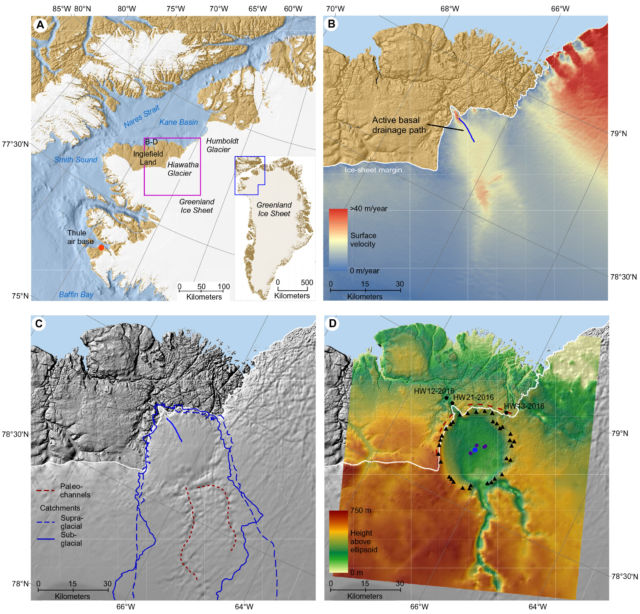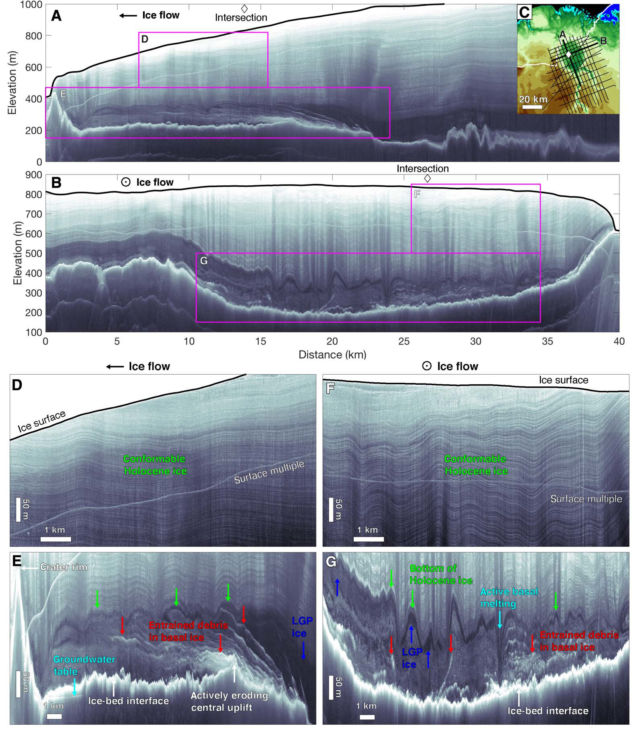You might not think of giant impact craters as being particularly subtle or in any way capable of hiding from us. If so, youll be surprised by the discovery, announced this week, of a 31-kilometer- (19-mile-) wide crater we didnt know existed.
Lets get the important questions out of the way—no, the crater isnt home to a Godzilla or some Lovecraftian horror. Its filled with ice. And thats how it escaped our notice for so long.
The crater lies beneath Hiawatha Glacier in northwestern Greenland. One of the tools researchers use to monitor the shrinking of the Greenland Ice Sheet is airborne radar surveys. The resulting high-resolution data shows the shape of the ice sheets surface, some of its internal layering, and even the bedrock below. In this case, it revealed a suspiciously circular depression in the ice near the glaciers edge.
On closer radar investigation, a team led by the University of Copenhagens Kurt Kjær found that this shape was no mere coincidence. A crisp, 320-meter-deep hole appeared in the bedrock data, complete with a slightly raised rim and central peak. But to confirm that it was a crater, the researchers needed to get their boots on the ground (or ice).

Buried beneath 900m of glacial ice, the hole couldnt be poked and prodded directly. But beyond the glaciers edge, sediment from the base of the glacier gets deposited along drainage channels—bits of the crater were brought to the researchers.
In those grains of sediment, the researchers found what they were looking for. There were small pieces of quartz bearing the tell-tale shock patterns seen in rocks smashed by impacts. And there were tiny bits of glass, too—molten rock that has been cooled almost instantly. Even the exposed bedrock displayed tiny faults parallel to the crater rim, which fits the impact crater explanation.
The chemistry of the sediment grains hints at what kind of object created the crater. Compared to the bedrock in the area, the grains contain extra iron, nickel, and other elements associated with iron meteorites.
With that in mind, the researchers calculated an estimate of the size of the impactor. Assuming a reasonable velocity of 20 kilometers per second, an iron meteorite with a diameter of about 1.5 kilometers (just under a mile) would make a crater this size. That would obviously be a violent event (as if the huge crater hadnt tipped you off).
When?
And that brings us to the million-dollar question: When did this happen? Its not the easiest question to answer, and as well explain in a moment, any answer promises to be controversial, so the studys discussion of age is pretty measured.
One clue is that the crater severs drainage channels in the bedrock. Two channels reach the “up-glacier” side of the crater, merging right at the rim. One channel can be seen on the opposite side of the crater, with nothing on the crater floor itself. That means that the channels likely pre-date the impact event, just as a street pre-dates a pothole.
Similar drainage channels under other glaciers in the area are thought to have originally been rivers before the Greenland Ice Sheet became a thing about 2.6 million years ago. But without a better idea of the channels age, knowing that the crater is younger than the channels doesnt tell you all that much.
The researchers also tried to analyze the shape of the crater to get a rough estimate of age based on its “freshness.” Plausible rates of glacial erosion put the age somewhere between 5,000 years and 50 million years, which doesnt exactly narrow it down.
The researchers best guess is based on the appearance of the ice layering in the radar data. Smooth, bright layering is visible most of the way down. Based on similar work elsewhere, this ice is known to go back about 12,000 years. Below that is a dark layer and a chaotic mash at the bottom.
The layer that looks dark to the radar instrument marks ice full of rocks and sediment that formed during a brief period of regional cooling known as the Young Dryas between 11,700 and 12,800 years ago. The chaos beneath it is strange, though, and doesnt appear in the radar images outside the crater. There, you find visually identifiable layers from older time periods.

The researchers interpret this to mean that the chaotic ice was around at the time of the impact—perhaps sliding in when the crater was fresh. That would put the date of the event somewhere between 2.6 million years ago and 12,000 years ago.
Here we go again
That last step is the debatable one and it where this gets controversial. To understand why, you need a little backstory on the Younger Dryas period.
Most research on the cause of this interesting climate event has focused on mechanisms that could disrupt Atlantic Ocean circulation and halt its heat transport—roughly the plot of The Day After Tomorrow. Dumping a bunch of freshwater into the North Atlantic is basically the way to jam up this circulation, and many scientists think that a sudden release of accumulated glacial meltwater from Canada is the likely culprit.
But thats not a certainty, and for the last decade a small group of scientists has been pushing a very different hypothesis—an impact event. The scientists claim has mostly centered on discoveries of purported impact fallout material at archeological sites in the North America. The problem is that none of those discoveries has stood up to the scrutiny of other scientists investigating the same sites. And, of course, there was no impact crater anywhere that fit the bill.
Predictably, that small group of scientists is awfully interested in this new crater. And since most people in this field consider the impact hypothesis to be completely unsupported—and are furthermore really sick of hearing about it—the authors of the crater study are in an awkward position. The paper reportedly underwent an unusually rigorous peer review process, with reviewers ensuring it didnt draw any casual connections to the Younger Dryas fight. Now that it has been published, others are already weighing in with skepticism.
So did the impact crater form right at the time of the Younger Dryas cooling? Or is it a couple million years older than that? Or is it older still, with the researchers misinterpreting the significance of the chaotic ice inside it? Only additional research will settle this. There doesnt seem to be any sign of material ejected from the crater in Greenland ice cores, for example, but modeling studies could clarify what signals we should look for. An ice core inside the crater would obviously be helpful, as could further examination of ice at the edge of the glacier, just past the crater.
Until then, about all we know is that a new impact crater—among the 25 largest in the world—has been added to the map. Thats an interesting story in itself, but the craters history remains to be filled in.
Science Advances, 2018. DOI: 10.1126/sciadv.aar8173 (About DOIs).
[contf] [contfnew] 
Ars Technica
[contfnewc] [contfnewc]






